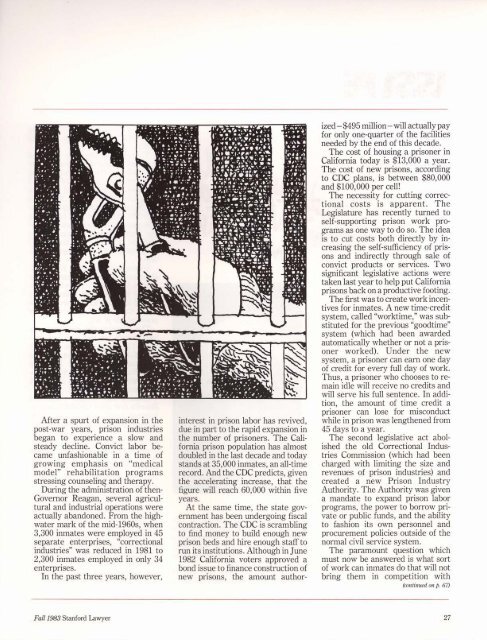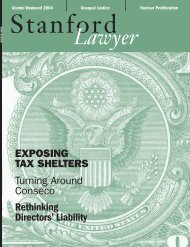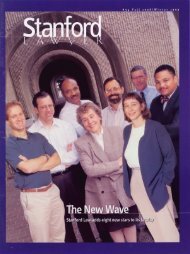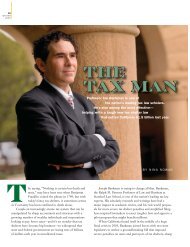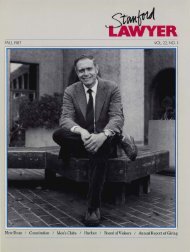AtISSUEPrison Labor:TimeTo Take Another LookBy Byron D. SherProfessor ofLawThe concept of prison labor hasbeen out of fashion in recentyears. In my view there arecompelling reasons to revive and expandwork programs for prisoners.Like many states, California haslong experience with prison labor. Infact, the California state constitutionexplicitly mandates the practice inthe following words: "the Legislatureshall, by law, provide for theworking of convicts for the benefit ofthe state" (Article XIV, Section 5).California's first state prison- SanQuentin- was founded on the principlethat the construction and operationof the institution should cost thetaxpayers little or nothing. Convictlabor would not only eliminate taxpayerexpense but also return aprofit to the private contractor whosupervised the convicts.Construction of San Quentin beganin 1852. A ship hulk, towed fromthe frontier city of San Francisco toPoint Quentin in Marin County,served as living quarters for bothmen and women prisoners whilethey built their new land-basedhome.After the prison was completed,the inmates were leased out to localfarmers and manufacturers for manuallabor. In 1858, however, scan-daIs over corruption and brutality atthe prison ended private operation ofSan Quentin.Due to overcrowding at San Quentin,a second state prison wasestablished in 1883 along theAmerican River near the town ofFolsom, a site with access to amplesupplies of both water and rock. TheNatoma Mining Company donatedthe land for the prison on the conditionthat it would control the quarryoutput after the prison itself wasfinished. Parts of the state capitolbuilding and the city of Sacramentoare made from granite rock quarried,cut, and crushed by Folsomprisoners.In furtherance of the notion thatthe prisons should cost the state aslittle as possible, a system of prisonindustries was soon started. At SanQuentin, for example, convicts wereemployed in the manufacture of jutebags for the storage of grain.(Previously, jute bags had been importedby the state and sold to localfarmers at a profit.)Extensive use of prison labor continuedin California and other statesuntil the Great Depression, whenhigh unemployment prompted thepassage of federal legislation to limitor halt the shipment of convict-madearticles in interstate commerce.These laws, most of which are stillon the books, have continued to hobblethe growth of many prison industries.World War II, with its labor shortages,temporarily reversed the declineof prison industries. Prisonlabor restrictions were set aside andthe War Production Board encouragedthe states to put their convictsto work. San Quentin's old jute millwas converted to the manufacture ofsandbags for the Marine Corps; thenew furniture factory became anassembly line for naval assaultcrafts; and textile plants were usedto recycle uniforms for the Pacificfleet.World War II also saw the birth ofCalifornia's conservation campsystem, which still uses inmates tofight fires and perform related conservationwork for the Departmentof Forestry. (Today there are stillnearly 3,000 prisoners in conservationcamps.)After the war the CaliforniaDepartment of Corrections (CDC)was established to turn the State'sdisparate prisons into a single,statewide correctional system. Thenew department decided to convertprison industries exclusively to theproduction of goods for the publicuse. Thus, in 1947, CDC receivedpermission to begin making automobilelicense plates at Folsom Prison.Approval to manufacture schooldesks at San Quentin soon followed.The trade-off for establishing newindustries was the legal agreementto limit purchase of prison productsto public agencies.26<strong>Stanford</strong> <strong>Lawyer</strong> <strong>Fall</strong> <strong>1983</strong>
After a spurt of expansion in thepost-war years, prison industriesbegan to experience a slow andsteady decline. Convict labor becameunfashionable in a time ofgrowing emphasis on "medicalmodel" rehabilitation programsstressing counseling and therapy.During the administration of thenGovernor Reagan, several agriculturaland industrial operations wereactually abandoned. From the highwatermark of the mid-1960s, when3,<strong>30</strong>0 inmates were employed in 45separate enterprises, "correctionalindustries" was reduced in 1981 to2,<strong>30</strong>0 inmates employed in only 34enterprises.In the past three years, however,interest in prison labor has revived,due in part to the rapid expansion inthe number of prisoners. The Californiaprison population has almostdoubled in the last decade and todaystands at 35,000 inmates, an all-timerecord. And the CDC predicts, giventhe accelerating increase, that thefigure will reach 60,000 within fiveyears.At the same time, the state governmenthas been undergoing fiscalcontraction. The CDC is scramblingto find money to build enough newprison beds and hire enough stafftorun its institutions. Although in June1982 California voters approved abond issue to finance construction ofnew prisons, the amount authorized- $495 million - will actually payfor only one-quarter of the facilitiesneeded by the end of this decade.The cost of housing a prisoner inCalifornia today is $13,000 a year.The cost of new prisons, accordingto CDC plans, is between $80,000and $100,000 per cell!The necessity for cutting correctionalcosts is apparent. TheLegislature has recently turned toself-supporting prison work programsas one way to do so. The ideais to cut costs both directly by increasingthe self-sufficiency of prisonsand indirectly through sale ofconvict products or services. Twosignificant legislative actions weretaken last year to help put Californiaprisons back on a productive footing.The first was to create work incentivesfor inmates. A new time-creditsystem, called "worktime," was substitutedfor the previous "goodtime"system (which had been awardedautomatically whether or not a prisonerworked). Under the newsystem, a prisoner can earn one dayof credit for every full day of work.Thus, a prisoner who chooses to remainidle will receive no credits andwill serve his full sentence. In addition,the amount of time credit aprisoner can lose for misconductwhile in prison was lengthened from45 days to a year.The second legislative act abolishedthe old Correctional IndustriesCommission (which had beencharged with limiting the size andrevenues of prison industries) andcreated a new Prison IndustryAuthority. The Authority was givena mandate to expand prison laborprograms, the power to borrow privateor public funds, and the abilityto fashion its own personnel andprocurement policies outside of thenormal civil service system.The paramount question whichmust now be answered is what sortof work can inmates do that will notbring them in competition with(continued on p. 67)<strong>Fall</strong> <strong>1983</strong> <strong>Stanford</strong> <strong>Lawyer</strong>27
- Page 1 and 2: RFAll 1983VOL. 18, NO.1Heroin Optio
- Page 3 and 4: jah(e,oYCONTENTSSTANFORD lAWYEREdit
- Page 5 and 6: Business Law vs. Public Interest La
- Page 7 and 8: By John Kaplanjockson Eli ReynoldsP
- Page 9 and 10: maintenance almost entirely up toth
- Page 11: smaller percentage of British addic
- Page 14 and 15: that, because of regulation, cannot
- Page 16 and 17: of a whole variety of new mortgagei
- Page 18 and 19: ConversationsWith Five AlumniBy Mic
- Page 20 and 21: y landlords and tenants about rents
- Page 22 and 23: when I was studying law and she was
- Page 24 and 25: ~o(1)AtISSUE *Union 'Rights' in the
- Page 26 and 27: AtISSUECongressional Responses toSu
- Page 30 and 31: Graduates and friends of theSchool
- Page 32 and 33: ~o~ 4'-VVcYi~STATE OF THE SCHOOLJoh
- Page 34 and 35: ~o~ Cff-VIMtu'0r-STATE OF THE SCHOO
- Page 36 and 37: ~o~ 4-(/141~STATE OF THE SCHOOL con
- Page 38 and 39: ~o~4VJ41~SUCCESSFUL LAWYERING:IMPLI
- Page 40 and 41: ~o~of-VJM~SUCCESSFUL LAWYERING cont
- Page 42 and 43: @.oarcA 4l!141~THE CONSTITUTION, RA
- Page 44 and 45: @o~4t1J41~.LAW AND BUSINESS PROGRAM
- Page 46 and 47: @otwrA 4vJ41~ .SUMMARY AND ADVISORY
- Page 48 and 49: David L. Engel(Harvard, JD '73)Bost
- Page 50 and 51: New Faculty (cont.)Michigan Law Sch
- Page 52 and 53: GILSON (cant.)Gilson is currently p
- Page 54 and 55: BabcockAwarded anHonorary LL.D.by S
- Page 56 and 57: CAREER 'ALTERNATIVES' (cant.)2. A s
- Page 58 and 59: Hurlbut WinnerTalks AboutTeachingPr
- Page 60 and 61: Schod;NI Grads Scatter toCities All
- Page 62 and 63: FACULTV NOTES (cant.) Professor Gun
- Page 64 and 65: it will be less so if we adopt a he
- Page 66 and 67: than on its edges, thus increasing
- Page 68 and 69: Heroin maintenance is, in manyways,
- Page 70 and 71: c~OTESII1912-25Hon. David Lee Rosen
- Page 72 and 73: c~NOTESthe firm advises, that "Donn
- Page 74 and 75: c~NOTESand had been prominent in a
- Page 76 and 77: spring Dean Ely traveledLEast, wher
- Page 78 and 79:
5Stanford LaWlers:This Page IsYours
- Page 80 and 81:
October 11Washington, DC LawSociety
- Page 82 and 83:
COMPARATIVE CONTRIBUTIONS TOTHE LAW
- Page 84 and 85:
A MESSAGE FROM THELAW FUND PRESIDEN
- Page 86 and 87:
CLASSAGENTSLong BeachSterling S. Cl
- Page 88 and 89:
Warren Christopher'49 Penny Howe Ga
- Page 90 and 91:
Frank L. Mallory '47Richard C. Mall
- Page 92 and 93:
Ronald G. Trayner '67Anthony J. Tre
- Page 94 and 95:
Walter A. Johnson, A.B. '29 Maxine
- Page 96 and 97:
DONORS TO THE LAW FUND• Hon. Murr
- Page 98 and 99:
CLASS OF 1948R. Winfield AchorHon.
- Page 100 and 101:
• Thomas R. MitchellR. Chandler M
- Page 102 and 103:
Paul E. Kreutz• Prof. Richard B.
- Page 104 and 105:
Gabriel M. GesmerMichael GilfixCorn
- Page 106 and 107:
HIGHEST LEVELSOF PARTICIPATIONLARGE
- Page 108 and 109:
FACULTY, FORMERFACULTY &STAFFBarbar
- Page 110 and 111:
REUNION GIVINGWhile class reunions
- Page 112 and 113:
DONORS TO SPECIALPROGRAMS AND FUNDS
- Page 114 and 115:
Class of 1954 Reunion Student Finan
- Page 116 and 117:
In Memory of:Clifton C. Cottrell '2
- Page 118 and 119:
Clyde E. Tritt'49William W. VaughnS
- Page 120:
BEQUESTS AND DEFERRED GIVINGBequest


